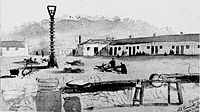William Lanne

William Lanne (also known as King Billy or William Laney) (c. 1835 – 3 March 1869) was a Tasmanian Aborigine. He is most well known as the last full-blooded Aboriginal Tasmanian man.
Lanne was captured along with his family in 1842 during a period known as the Black War. He was the youngest child in the last family taken to the Aboriginal camp at Wybelenna on Flinders Island by George Augustus Robinson. His native name is lost, probably because at 7 he was too young when arriving at Wybalenna and so the English name William he was given there stuck.
In 1847, he temporarily moved to Oyster Cove, and was sent to an orphanage in Hobart until 1851. In 1855 he joined a whaling ship and regularly visited Oyster Cove when he had time.
Lanne died on 3 March 1869 from a combination of cholera and dysentery.

Following his death his body was dismembered and used for scientific purposes. An argument broke out between the Royal College of Surgeons of England and the Royal Society of Tasmania over who should possess his remains. It was reported that someone, allegedly a member of the English College of Surgeons named William Crowther, managed to break into the morgue where Lanne's body was kept and decapitated the corpse, removed the skin and inserted a skull from a white body into the black skin. The Tasmanian Royal Society soon discovered Crowther's work, and decided to thwart any further attempts to collect "samples" by amputating the hands and feet and discarding them separately. Lanne was then buried in this state.[1]
(From David Davies, 1973 "The last of the Tasmanians", Frederick Muller, London. 235-6):
"Dr. Crowther of the hospital vainly applied to the Government for permission to send the skeleton to the Royal College of Surgeons in London. However, a rather macabre note was struck at Lanne's funeral, for it was found that the head of the corpse was missing. During the night after the burial the rest of the body was dug up and several parts removed. Crowther was blamed for the removal of the head and his honorary appointment as surgeon at the Colonial Hospital terminated, but it is interesting to note that the Council of the Royal College of Surgeons awarded him during 1869 a gold medal and a Fellowship of the College, the first instance of an Australian having been given this honour."
Although it is not known what happened to the stolen remains of Lanne, a report in The Times in 1912 headed "Conversazione of the Royal Society: recent advances in science" mentions the exhibition of "the desiccated brain of an aboriginal Tasmanian"[2]
William Lanne's name is believed to be the source of the "King Billy Pine",[3] or Athrotaxis, a native Tasmanian tree whose wood is renowned for its durability to rot and insects.
External links
| Wikimedia Commons has media related to William Lanne. |
| Look up King Billy in Wiktionary, the free dictionary. |
References
- ↑ "THE ABORIGINES OF TASMANIA - "King Billy", whose death we recently recorded, was the last man of a race which only half a century ago numbered 7,000 souls. There is still an aged woman left of the aboriginal population of Tasmania. There has been an unseemly struggle for the skeleton of "King Billy". He died at Hobart Town, and his body was taken to the dead-house of the General Hospital. It is stated that on the night before the funeral a medical gentleman connected with the hospital abstracted the skull, intending to send it to the English College of Surgeons, and inside the scalp the skull of the corpse of a white man, also in the dead-house, was inserted in lieu of that which had been removed. When this mutilation was discovered the hands and feet were cut off to frustrate any attempt of the first mutilator to obtain the whole skeleton. The trunk was then buried, the coffin carried to the grave covered with a black opossum skin rug, and followed by above a hundred citizens. In the following night, it is stated, the body was raised from the grave by order of the house surgeon of the hospital. What will be the fate of the head does not appear to be known, but the rest of the skeleton was to go to the museum of the Royal Society of Tasmania." - The Times, Saturday, 29 May 1869; pg. 9; Issue 26450; col E
- ↑ The Times, Thursday, 9 May 1912; pg. 4; Issue 39894; col A : "A rather gruesome exhibit was that of Professor Elliot Smith, the desiccated brain of an aboriginal Tasmanian, believed to be the only Tasmanian brain now in existence."
- ↑ "Native Conifers of Tasmania". Parks and Wildlife Service Tasmania. 17 July 2008. Retrieved 9 August 2011.
| ||||||||||||||||||||||||||||